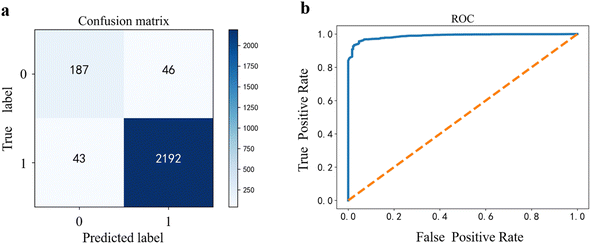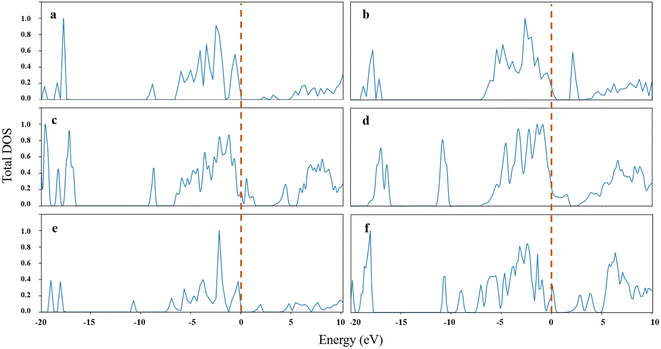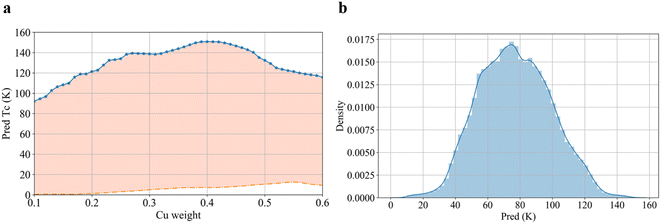 Open Access Article
Open Access ArticleCuprate superconducting materials above liquid nitrogen temperature from machine learning†
Yuxue Wang‡
 abc,
Tianhao Su‡
abc,
Tianhao Su‡ abc,
Yaning Cuiabc,
Xianzhe Maabc,
Xue Zhoud,
Yin Wang
abc,
Yaning Cuiabc,
Xianzhe Maabc,
Xue Zhoud,
Yin Wang abc,
Shunbo Hu
abc,
Shunbo Hu *abc and
Wei Ren
*abc and
Wei Ren *abc
*abc
aDepartment of Physics, Material Genome Institute, Institute for the Conservation of Cultural Heritage, Shanghai University, Shanghai 200444, China. E-mail: renwei@shu.edu.cn; shunbohu@shu.edu.cn
bShanghai Key Laboratory of High Temperature Superconductors, International Center for Quantum and Molecular Structures, Shanghai University, Shanghai 200444, China
cZhejiang Lab, Hangzhou 311100, China
dCenter for Spintronics and Quantum Systems, State Key Laboratory for Mechanical Behavior of Materials, Xi'an Jiaotong University, Xi'an, Shaanxi 710049, China
First published on 3rd July 2023
Abstract
The superconductivity of cuprates remains a challenging topic in condensed matter physics, and the search for materials that superconduct electricity above liquid nitrogen temperature and even at room temperature is of great significance for future applications. Nowadays, with the advent of artificial intelligence, research approaches based on data science have achieved excellent results in material exploration. We investigated machine learning (ML) models by employing separately the element symbolic descriptor atomic feature set 1 (AFS-1) and a prior physics knowledge descriptor atomic feature set 2 (AFS-2). An analysis of the manifold in the hidden layer of the deep neural network (DNN) showed that cuprates still offer the greatest potential as superconducting candidates. By calculating the SHapley Additive exPlanations (SHAP) value, it is evident that the covalent bond length and hole doping concentration emerge as the crucial factors influencing the superconducting critical temperature (Tc). These findings align with our current understanding of the subject, emphasizing the significance of these specific physical quantities. In order to improve the robustness and practicability of our model, two types of descriptors were used to train the DNN. We also proposed the idea of cost-sensitive learning, predicted the sample in another dataset, and designed a virtual high-throughput search workflow.
1 Introduction
Ever since the discovery of superconductivity in mercury at low temperatures,1 physicists have continued to explore this fascinating quantum material. In 1950, Maxwell and Reynolds et al. discovered the isotope effect of superconductor mercury,2,3 which inspired Bardeen, Cooper, and Schrieffer to propose the BCS theory. The BCS theory explains the isotope effect perfectly, where the superconducting critical temperature (Tc) formula is expressed as , where ΘD represents the Debye temperature, N(0) is the electronic density of states near the Fermi level, and V refers to the electron–phonon coupling potential.4,5 The BCS theory explains the isotope effect perfectly for
, where ΘD represents the Debye temperature, N(0) is the electronic density of states near the Fermi level, and V refers to the electron–phonon coupling potential.4,5 The BCS theory explains the isotope effect perfectly for  , Tc ∼ M−α, and
, Tc ∼ M−α, and  .6,7 Decades later, in 1986, Bednorz and Müller pioneeringly discovered the cuprate Ba–La–Cu–O (BLCO) to be a high-Tc superconductor. To date, the highest Tc record holder of cuprates, obtained by Eggert and Gao et al., is Hg–Ba–Ca–Cu–O with a Tc of 164 K under a high pressure of up to 16 kbar.8,9 The compounds mentioned above are among many above-liquid-nitrogen-temperature cuprate superconductors classified as Y, Bi, Tl, and Hg series.
.6,7 Decades later, in 1986, Bednorz and Müller pioneeringly discovered the cuprate Ba–La–Cu–O (BLCO) to be a high-Tc superconductor. To date, the highest Tc record holder of cuprates, obtained by Eggert and Gao et al., is Hg–Ba–Ca–Cu–O with a Tc of 164 K under a high pressure of up to 16 kbar.8,9 The compounds mentioned above are among many above-liquid-nitrogen-temperature cuprate superconductors classified as Y, Bi, Tl, and Hg series.
Detecting the isotope effect of conventional superconductors only involves the isotope substitution of a few kinds of atoms, which is relatively simple. However, the isotope effect in cuprates is more complex than in conventional superconductors, with the α value changing with the hole-doping concentration.6,10,11 While the BCS theory based on electron–phonon coupling can explain some of the isotope effects of La series cuprate superconductors, it fails for the isotope effect counterparts in Y, Bi, Tl, and Hg series cuprate superconductors.6,7,12–14 It is widely accepted that even though electron–phonon coupling could induce high-Tc superconductivity, the cuprates are still believed not to be determined as phonon-mediated.13–25
Machine learning (ML) has become an essential data-driven research approach that has been rapidly developed in recent years.26 In contrast to traditional methods, ML does not rely on the development of any prior physical knowledge (e.g., Debye temperature or phonon dynamics properties)27 but utilizes data to explore the physical rules, showing outstanding performances in scientific research and industrial design.28–38 Stanev et al. reported ML models to explore the rule of the superconducting transition temperature.39 Xie et al. applied the sure independence screening and sparsifying operator (SISSO) approach to search for mathematical formulas related to superconductivity with smaller errors.40,41 In a study by Mori et al., the synthesis of machine-learning-assisted materials was applied to accelerate the exploration of novel thin film superconductors.42 These studies have shown the feasibility of utilizing ML for data mining in the search of superconducting materials and inspired us to carry out the present investigation.
Physics-informed neural networks (PINNs)43,44 are a type of neural network whose training process incorporates physical principles or equations as constraints. This method has various advantages over conventional neural networks, including the capacity to incorporate a system's priorities and the potential to avoid overfitting and enhance generalization. The use of PINNs to handle small data sets, a prevalent issue in many physics-based applications, is one of the primary advantages of this method. By introducing physical restrictions, PINNs may utilize available data to create accurate predictions and enhanced performance. However, the utilization of physical constraints might also result in network limitations. For instance, if the physical equations or rules employed in the network are inaccurate or insufficient, the network's performance may suffer. In addition, the introduction of physical restrictions increases the architecture's complexity, which may necessitate additional processing resources and lengthier training cycles.
Cuprate materials are a significant class of superconducting materials, and the enhancement of their superconducting transition temperature has long been an important area of superconductivity study. Nonetheless, there is currently no developed theoretical model that can correlate the superconducting transition temperature of these materials, which poses significant hurdles for the research community. Consequently, despite the fact that the PINNs approach has yielded outstanding results in a variety of disciplines, it is now inapplicable due to its inability to deal with the superconducting transition temperature of cuprate materials.
Our approach to overcoming this limitation involves designing a feature engineering process based on prior physical knowledge, followed by utilizing manifold learning to determine the direction for material design. We analyzed SHapley Additive exPlanations (SHAP) values and found that shorter covalent bonds and lower hole-doping concentrations are effective ways to enhance the Tc for most materials. To improve the accuracy of our model, we established a cost-sensitive ML model to resolve sample imbalance and an ensemble learning model using two deep neural networks (DNN) with non-correlation characteristics.
We found that tree-based regression models lack the ability to extrapolate the higher superconducting transition temperature outside the dataset's range, while support vector machines (SVMs) rely heavily on challenging feature engineering, and so DNN was finally chosen as our extrapolation model for regression prediction due to the difficulties of feature engineering and the desire to reunite knowledge fragments. We used a Monte Carlo-based test set partitioning strategy to prevent data leakage caused by repetitive optimizations of the test set, hence retaining the generalization performance of the model. However, in our scenario, the inclusion of framework and parameter hyperparameters, as well as Monte Carlo data set partitioning, made optimization particularly difficult; therefore, the Tree-structured Parzen Estimator (TPE) method based on the Bayesian optimization algorithm was employed to perform the optimization.
We then applied the model to predict high-Tc materials and performed virtual high-throughput (VH) screening of superconductors in a larger space. By combining conclusions obtained from domain knowledge, our work resulted in an ML model with specific explanatory capabilities.
2 Methods
2.1 Data source
We chose the Supercon database as our dataset source.45 After removing the data without the exact chemical formula, we took the median temperature for those of the same chemical formula corresponding to multiple Tc, as the median was actually obtained in the experiment.46 After the screening, 12![[thin space (1/6-em)]](https://www.rsc.org/images/entities/char_2009.gif) 340 Tc data were collected, with a small number of materials having structural information from the literature. As shown in Fig. S1,† most of the materials had Tc values of less than 20 K, and only a few materials had critical temperatures greater than 120 K, and the highest Tc material was Hg0.66Pb0.34Ba2Ca1.98Cu2.9O8.4 with Tc = 143 K.
340 Tc data were collected, with a small number of materials having structural information from the literature. As shown in Fig. S1,† most of the materials had Tc values of less than 20 K, and only a few materials had critical temperatures greater than 120 K, and the highest Tc material was Hg0.66Pb0.34Ba2Ca1.98Cu2.9O8.4 with Tc = 143 K.
2.2 Feature engineering
Two kinds of descriptors were used in this work, namely the atomic feature set 1 (AFS-1) and atomic feature set 2 (AFS-2). The feature extraction of AFS is based on ‘cell’ processing, in which we define all the elements in the normalization formula as a ‘pseudo cell,’ and its stoichiometric number is the weight of each element. AFS-1 is the symbolic element one-hot encoding based on the properties of the elemental components, it is a vector defined by multidimensional elements as a mapping vector composed of the elements in the chemical formula, and we can view it as a vector with a high dimension. For AFS-1, the dimension of the vector space of the whole feature is equal to the sum of the elements number in the periodic table of elements. In the feature space of AFS-1, the neural network's self-processing of the features might even go beyond the artificially designed descriptors.47 AFS-2 was established on the physical properties of the component elements. A file is required and it is used to fill in the characteristics of each element according to the users' domain knowledge. We use this series of physical quantities as descriptors supported by the following superconductivity prior knowledge: (a) according to Zhao et al., Tc may have a relationship with the valence of copper,48 and then the Jahn–Teller effect in the superconducting sample;49 (b) the mainstream theory of cuprate high-temperature superconductors resonance valence bond theory (RVB),50 Zhang–Rice Model (ZRM),51 and t–J model;52 (c) SO(5) supersymmetry theory,53 according to the theory that Tc is most related to the electron-doping concentration; (d) there is a relationship between Tc, the electronic structure (Cu d orbitals or Cu–O chemical bonds), and the magnetic structure (mainly the magnitude of the exchange coupling integral J, and then the correlation energy U).54–62 In details, (1) superconductivity was obtained by the magnetic exchange interaction and Fermi surface; (2) the impact of Jahn–Teller effect and crystal field restricts the electron number in superconductivity. And (e) the polarons and plasmon, whereby Tc is related to the factor of the conformation of the polarons, hole concentration, and parameters concerning the lattice conformation of a (or the) layered structure.15 As an excellent descriptor should be universal and accessible, we considered using basic descriptors for mapping basic influencing factors, as shown in Table S1.† AFS-2 was used to calculate the features in the cell. According to the attributes of the input elements, we designed the treatment of the characteristics of doped systems. AFS-1 and AFS-2 were converted into convenient software, with the details given in the ESI.†3 Results and discussion
3.1 Cost-sensitive classification model
We used the PyCaret library for model selection,63 and then got the first four models to show stable performance for both descriptors, with their 10-fold cross-validation accuracy rates shown in Table 1. Taking the random forest (RF) model for AFS-1 to train as our basic model, the confusion matrix and receiver operating characteristic (ROC) curve are shown in Fig. 1.| Model | AFS-1 | AFS-2 | AFS-1&AFS-2 |
|---|---|---|---|
| KNN | 0.9639 | 0.9548 | 0.9574 |
| DT | 0.9549 | 0.9434 | 0.9541 |
| RF | 0.9658 | 0.9599 | 0.9636 |
| AB | 0.9569 | 0.9541 | 0.9574 |
The critical temperature of liquid nitrogen, 77 K, was adopted as the temperature boundary, i.e., low Tc is below 77 K while high Tc is above it. In Fig. 1, we got the confusion matrix on a random test and the AUC score of about 0.98, but there were two notable issues in the analysis of the classified datasets: (a) the uneven distribution of samples, i.e., 1233 high-Tc materials versus 11![[thin space (1/6-em)]](https://www.rsc.org/images/entities/char_2009.gif) 107 low-Tc in the dataset; (b) the two materials in the misjudgment cost model were different, that is, the model predicted high-Tc for low-Tc materials penalty (serious error) versus the low-Tc predicted for high-Tc materials penalty (general error), so we applied an ML model adjustment by setting an additional penalty of 1.5 times to serious errors more than the general error, and thus obtained the ideal threshold by observing the cost function curve. As shown in Fig. 2, the lowest point of the cost curve was selected as the threshold of the RF model classifier. Since even a trained model has a certain degree of randomness, we should find the interval with the best threshold near the lowest value. After passing the sliding threshold test, the threshold range was determined to be 0.44 ± 0.03, and within this threshold interval, the serious error was reduced to 29 and the general error rose to 55, while the accuracy was not compromised. See the ESI† for the graph of the sliding threshold interval.
107 low-Tc in the dataset; (b) the two materials in the misjudgment cost model were different, that is, the model predicted high-Tc for low-Tc materials penalty (serious error) versus the low-Tc predicted for high-Tc materials penalty (general error), so we applied an ML model adjustment by setting an additional penalty of 1.5 times to serious errors more than the general error, and thus obtained the ideal threshold by observing the cost function curve. As shown in Fig. 2, the lowest point of the cost curve was selected as the threshold of the RF model classifier. Since even a trained model has a certain degree of randomness, we should find the interval with the best threshold near the lowest value. After passing the sliding threshold test, the threshold range was determined to be 0.44 ± 0.03, and within this threshold interval, the serious error was reduced to 29 and the general error rose to 55, while the accuracy was not compromised. See the ESI† for the graph of the sliding threshold interval.
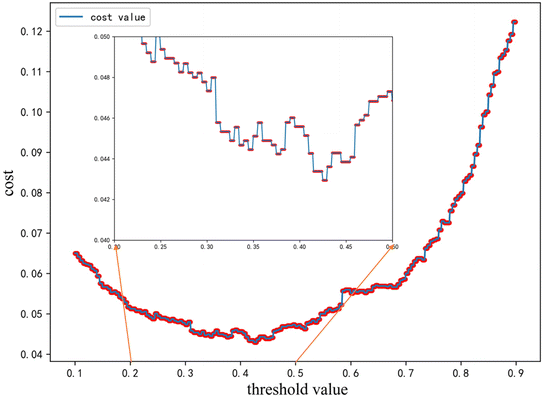 | ||
| Fig. 2 Misclassification inequality cost function curve, where the local optimal threshold value was around 0.42 and sliding thresholds were needed to search the global optimal threshold value. | ||
3.2 Situation-adaptive regression model
From the regression analysis (Fig. 3 and S5†), we can find that the DNN trained based on AFS-1 had less error than AFS-2, but that does not necessarily mean that AFS-1 was better (see ESI†). For example, for Pr, Tb, Ho, Tm, and Sm elements, the DNN based on AFS-2 predicted their Tc to be 0 K, but the DNN based on AFS-1 gave Tc values of 15.91, 9.22, 8.88, 17.24, and 6.34 K, though these materials were not superconducting.64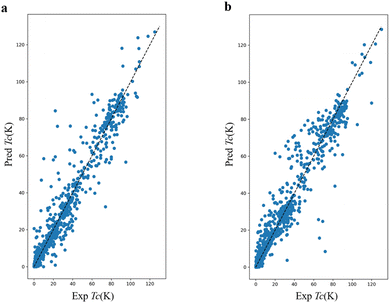 | ||
| Fig. 3 (a) DNN trained by using AFS-1 results: R2 = 0.95, RMSE = 6.08 K, MAE = 3.08 K. (b) DNN trained by using AFS-2 results: R2 = 0.93, RMSE = 7.35 K, MAE = 3.73 K. | ||
3.3 Model interpretation
RF model can extract the importance of features according to the branching situation of sub-trees during training, and here we calculated the SHAP value in order to refine the influence of the feature on the target value and analyzed the SHAP value of the top 20 importance features from AFS-2.65In Fig. 4, the top-to-bottom features represent the degree of influence on Tc. We found the feature having the greatest impact on Tc was the longest value of the covalent bond in a cell. When the distribution value of this feature was lowered, the Tc increased, as this feature was mentioned four times in five prior knowledge. From the RVB theory, we can qualitatively state that the J/t value in the t–J model will decrease when the ionic bond is short. The second important feature was the average number of unfilled electrons in a cell, whose high values (in red) appeared near the minimum and small SHAP values. For hole doping in cuprates, the influence of the concentration is such that Tc increases when the hole concentration decreases, but with an optimal concentration range, and overdoping will reduce the Tc value. This is qualitatively consistent with the inference of SO(5) theory when the holes concentration was high, and experiments show that the properties of high-temperature superconductors are metalized rather than insulators, so electrons are easy to hop and the J/t value will also be affected. This is consistent with the analysis in the first feature, so the first two features selected by the ML were self-consistent in theory. The third important feature was the maximum row value of an element in the periodic table, reflecting the influence of the cycle of the elements on Tc. As a rule summarized by ML, the upper rows of the periodic table have a greater influence on Tc.
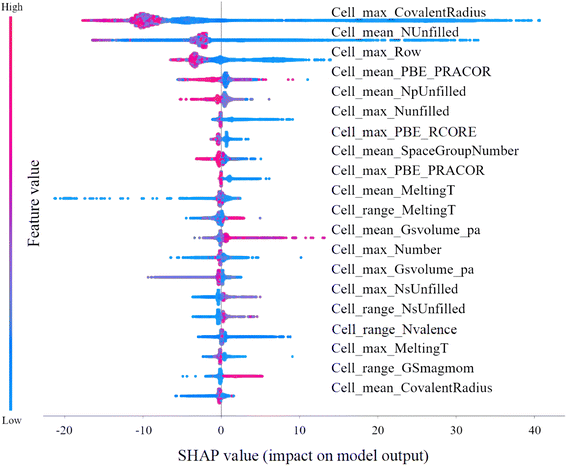 | ||
| Fig. 4 SHAP values of top 20 important features of AFS-2, which indicate the impact of the feature values on the variation on Tc. | ||
Manifold learning is considered to be an important way to understand high-dimensional data structures. Since the t-distributed stochastic neighbor embedding (T-SNE) reduction visualization data overlap the least, this was selected as the dimensionality reduction method (Fig. S7†). In Fig. 5, it can be found that there was a great correlation between the content of Cu reflected in this two-dimensional mapping space and the Tc, so this was indeed a suitable choice to set Cu-based (cuprate) superconducting materials by DNN. The Fe content was reflected in the middle of the manifold region, which indicated that the Tc of Fe-based superconductors is not as high as that of Cu-based superconductors, and this was indeed the case in the experiments.67–69 In terms of the stoichiometry weight of the elements, there are some elements that are restricted to specific intervals. For example, the O content in cuprates should be within a proper range. Otherwise, it will transform into semiconductors or even insulators,70–73 and a similar phenomenon also exists for Cu and Fe. In contrast, Ba and La were obviously different, as they were scattered in various parts of the manifold space without specific intervals. The characteristic dying in the manifold and the distribution of target values can provide component references in the material design.
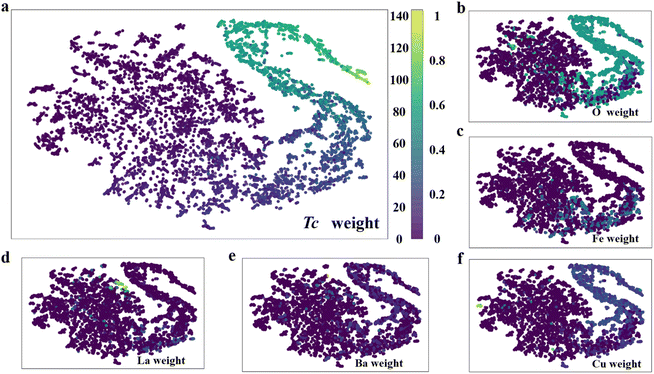 | ||
| Fig. 5 Two-dimensional mapping space under the dimension reduction of t-distributed stochastic neighbor embedding (T-SNE).66 (a) Tc by the materials weight mapping in this two-dimensional space. (b)–f. O, Fe, La, Ba, and Cu stoichiometric numbers by the materials' weight mapping in this two-dimensional space. The color column represents the Tc (left) and component (right) in materials. | ||
3.4 Model application
The predicted values of the average from two neural networks were chosen as the prediction basis for an ensemble ML model, and we named it e-DNN. Materials in the Materials Project (MP) database were predicted by applying the e-DNN model,74 with the distribution of Tc, and the best candidates are shown in Fig. S2.† It can be seen that the distribution of Tc was the same as the distribution of the training data. The complete prediction document is given in the ESI.†In the set of predictions for the MP database, we found evidence of some possible high-Tc materials from their electronic structure. For known cuprate superconductors, flat-bands below the energy of the highest occupied electronic state lead to a large peak in the electronic to help enhance Tc; more importantly, DOS peaks close to EF due to the Van Hove singularity may also enhance Tc.75 As shown in Fig. 6, most of our predicted cuprate candidate samples have peaks near the EF of DOS, which greatly complies with the laws of physics, as we discussed in 2.2.
There are some data with missing Tc labels in the Supercon database, though these existing materials are feasible for experimental synthesis (Table 2). The average absolute value difference of two DNN predicted results was about 10 K, as there was a huge disparity in the prediction results of some data. These data can be roughly divided into three categories: experiments under high pressure, non-superconducting materials, and material information flaws (some data might have been incorrectly inputted into the database).
| Formula | Tc (AFS-1) | Tc (AFS-2) |
|---|---|---|
| La1.8Nd0.2Ba2Ca0.4Cu4.4O7.183 | 103.18 | 97.53 |
| Bi1.6Pb0.3V0.1Sr2Ca2Cu3O9.92 | 96.31 | 88.24 |
| Bi1.6Pb0.35V0.05Sr2Ca2Cu3O9.92 | 94.68 | 89.26 |
| Tb1Ba2Cu3O7 | 92.83 | 88.12 |
| Bi2Sr2Ca0.5Er0.5Cu2O8 | 90.35 | 83.66 |
| Y1Ba2Cu3H0.43O6.91 | 89.46 | 80.12 |
| Y0.76Lu0.24Ba2Cu4O8 | 87.91 | 89.94 |
| Ba1.6Sr0.4Yb1Cu3O6.42 | 87.72 | 80.25 |
| Ba1.6Sr0.4Yb1Cu3O6.26 | 86.72 | 81.17 |
| Y0.8Eu0.2Ba2Cu3O7 | 85.99 | 81.57 |
| Eu1Ba1Sr0.6Ca0.4Cu3O6.95 | 85.30 | 95.47 |
| Ba1.6Sr0.4Yb1Cu3O6.15 | 85.29 | 82.43 |
| Y1Ba2Cu3O6.975 | 84.38 | 80.67 |
| Er1Ba2Cu3O6.95 | 84.18 | 88.58 |
| Er1Ba2Cu3O6.88 | 84.01 | 90.65 |
| Cu9.5Sr2Ca8Cr0.5O21.05 | 83.51 | 80.24 |
| Ba1.6Sr0.4Yb0.85Ca0.15Cu3O6.17 | 82.75 | 80.92 |
| Pb0.5Sr2Ca1Cu2.5O7.4 | 82.12 | 83.19 |
| Ca0.1Ba1.65Nd1.25Cu3O7.03 | 81.70 | 86.93 |
| Ba1.6Sr0.4Yb1Cu3O5.97 | 81.09 | 88.07 |
| Pb2Sr2Y0.5Ca0.5Cu3O9.4 | 80.15 | 85.54 |
In statistics, a confidence interval (CI) is a range of estimates for an unknown parameter, computed at a designated confidence level. The CI shows the degree of confidence in the measured value of the parameter, e.g., a 95% confidence level is most common, but other levels (such as 90% or 99%) are sometimes used.
The CI is calculated by the following formula:
| {upper, lowerbound} = X ± z × RMSE. |
Based on the distribution characteristics of the datasets, a series of virtual samples could be designed for prediction.77,78 Here, we took the samples containing the Hg–Pb–Ba–Ca–Cu–O composition as an example to perform a VH search. As a result of Fig. 7, Hg0.13Pb0.09Ba0.32Ca0.422Cu0.4O1 was found to have the highest Tc of 152 K, which represents a prediction of the optimal value generated by the combination of five metal elements and the O element in the chemical formula. There also are many other frequently appearing elements in the data set, such as Sr and Y; therefore, VH samples can also be set up by the above methods, but we suggest that the Cu–O base should be used and combined with other elements to construct virtual samples, and then to predict the composition of the compounds of interest (the element richness information and VH design method are given in the ESI†).
4 Conclusion
In summary, we developed cost-sensitive classification and situation-adaptive regression ML models to mitigate prediction risks. Two descriptors, AFS-1 and AFS-2, were chosen for comparison and supplementation in predicting Tc for known components as well as for unknown Tc and VH screening. SHAP analysis revealed that shortening covalent bond lengths and increasing hole-doping concentrations are the two physical factors that can increase the Tc. Our work provides a practical and accurate ML model for predicting the Tc of unknown materials, and can offer valuable guidance for future experiments.Code availability
The code and datasets for our work are available online from the following GitHub link. https://github.com/Suth-ICQMS/AFS.Conflicts of interest
There are no conflicts to declare.Acknowledgements
This work was supported by the National Natural Science Foundation of China (52271007, 12074241, 52130204, 11929401), the Science and Technology Commission of Shanghai Municipality (22XD1400900, 21JC1402600, 21JC1402700, 20501130600), High Performance Computing Center, Shanghai Technical Service Center of Science and Engineering Computing, Shanghai University, Shanghai Supercomputer Center, and Key Research Project of Zhejiang Laboratory (No. 2021PE0AC02), the Key Research and Development Program of Shaanxi Province (Grant No. 2021GXLH-Z-065). We also would like to acknowledge Dr Ouyang Runhai for discussions.References
- H. K. Onnes, in Proceedings koninklijke akademie van wetenschappen te amsterdam, 1911, vol. 13, pp. 1274–1276 Search PubMed.
- C. A. Reynolds, B. Serin, W. H. Wright and L. B. Nesbitt, Superconductivity of Isotopes of Mercury, Phys. Rev., 1950, 78, 487 CrossRef CAS.
- E. Maxwell, Isotope Effect in the Superconductivity of Mercury, Phys. Rev., 1950, 78, 477 CrossRef CAS.
- J. Bardeen, L. N. Cooper and J. R. Schrieffer, Microscopic Theory of Superconductivity, Phys. Rev., 1957, 106, 162–164 CrossRef CAS.
- J. Bardeen, L. N. Cooper and J. R. Schrieffer, Theory of Superconductivity, Phys. Rev., 1957, 108, 1175–1204 CrossRef CAS.
- Z.-Z. Li, Solids Theory: A Postgraduate Teaching Book, High Education Press, 2002, vol. 2 Search PubMed.
- J. R. Schrieffer, Theory Of Superconductivity, CRC Press, Boca Raton, 2019 Search PubMed.
- J. H. Eggert, J. Z. Hu, H. K. Mao, L. Beauvais, R. L. Meng and C. W. Chu, Compressibility of the HgBa2Can−1CunO2n+2+δ(n = 1, 2, 3) high-temperature superconductors, Phys. Rev. B: Condens. Matter Mater. Phys., 1994, 49, 15299–15304 CrossRef CAS PubMed.
- L. Gao, Y. Y. Xue, F. Chen, Q. Xiong, R. L. Meng, D. Ramirez, C. W. Chu, J. H. Eggert and H. K. Mao, Superconductivity up to 164 K in HgBa2Cam−1CumO2m+2+δ (m =1, 2, 3) under quasihydrostatic pressures, Phys. Rev. B: Condens. Matter Mater. Phys., 1994, 50, 4260–4263 CrossRef CAS PubMed.
- D. M. Ginsberg, Physical Properties Of High Temperature Superconductors, World Scientific, 1998, vol. 1 Search PubMed.
- U. Rössler, Solid State Theory: An Introduction, Springer Science & Business Media, 2013 Search PubMed.
- O. Isayev, D. Fourches, E. N. Muratov, C. Oses, K. Rasch, A. Tropsha and S. Curtarolo, Materials Cartography: Representing and Mining Materials Space Using Structural and Electronic Fingerprints, Chem. Mater., 2015, 27, 735–743 CrossRef CAS.
- A. Lanzara, P. V. Bogdanov, X. J. Zhou, S. A. Kellar, D. L. Feng, E. D. Lu, T. Yoshida, H. Eisaki, A. Fujimori, K. Kishio, J.-I. Shimoyama, T. Noda, S. Uchida, Z. Hussain and Z.-X. Shen, Evidence for ubiquitous strong electron–phonon coupling in high-temperature superconductors, Nature, 2001, 412, 510–514 CrossRef CAS PubMed.
- R. K. Pandey, S. P. Singh and P. Singh, A Possible Explanation of Critical Temperature and Isotope Effect Coefficient of High Tc Cuprate Superconductors, J. Supercond., 1998, 11, 663–665 CrossRef CAS.
- V. Z. Kresin and S. A. Wolf, Colloquium : Electron-lattice interaction and its impact on high Tc superconductivity, Rev. Mod. Phys., 2009, 81, 481–501 CrossRef.
- D. Oh, D. Song, Y. Kim, S. Miyasaka, S. Tajima, J. M. Bok, Y. Bang, S. R. Park and C. Kim, B1g-Phonon Anomaly Driven by Fermi Surface Instability at Intermediate Temperature in YBa2Cu3O7−δ, Phys. Rev. Lett., 2021, 127, 277001 CrossRef CAS PubMed.
- A. Ramos-Alvarez, N. Fleischmann, L. Vidas, A. Fernandez-Rodriguez, A. Palau and S. Wall, Probing the lattice anharmonicity of superconducting YBa2Cu3O7 via phonon harmonics, Phys. Rev. B, 2019, 100, 184302 CrossRef CAS.
- S. Sarkar, M. Grandadam and C. Pépin, Anomalous softening of phonon dispersion in cuprate superconductors, Phys. Rev. Res., 2021, 3, 013162 CrossRef CAS.
- D. M. Newns and C. C. Tsuei, Fluctuating Cu–O–Cu bond model of high-temperature superconductivity, Nat. Phys., 2007, 3, 184–191 Search PubMed.
- W. Hu, S. Kaiser, D. Nicoletti, C. R. Hunt, I. Gierz, M. C. Hoffmann, M. Le Tacon, T. Loew, B. Keimer and A. Cavalleri, Optically enhanced coherent transport in YBa2Cu3O6.5 by ultrafast redistribution of interlayer coupling, Nat. Mater., 2014, 13, 705–711 CrossRef CAS PubMed.
- R. Mankowsky, A. Subedi, M. Först, S. O. Mariager, M. Chollet, H. T. Lemke, J. S. Robinson, J. M. Glownia, M. P. Minitti, A. Frano, M. Fechner, N. A. Spaldin, T. Loew, B. Keimer, A. Georges and A. Cavalleri, Nonlinear lattice dynamics as a basis for enhanced superconductivity in YBa2Cu3O6.5, Nature, 2014, 516, 71–73 CrossRef CAS PubMed.
- G.-H. Gweon, T. Sasagawa, S. Y. Zhou, J. Graf, H. Takagi, D.-H. Lee and A. Lanzara, An unusual isotope effect in a high-transition-temperature superconductor, Nature, 2004, 430, 187–190 CrossRef CAS PubMed.
- Q. Xiong, J. W. Chu, Y. Y. Sun, H. H. Feng, S. Bud'ko, P. H. Hor and C. W. Chu, High-pressure study of the anomalous isotope effect in La2−xAxCuO4 with A = Sr or Ba, Phys. Rev. B: Condens. Matter Mater. Phys., 1992, 46, 581–584 CrossRef CAS PubMed.
- P. Boolchand, R. N. Enzweiler, I. Zitkovsky, J. Wells, W. Bresser, D. McDaniel, R. L. Meng, P. H. Hor, C. W. Chu and C. Y. Huang, Softening of Cu–O vibrational modes as a precursor to onset of superconductivity in EuBa2Cu3O7−δ, Phys. Rev. B: Condens. Matter Mater. Phys., 1988, 37, 3766–3769 CrossRef CAS PubMed.
- B. K. Chakraverty, Possibility of insulator to superconductor phase transition, J. Phys. Lett., 1979, 40, 99–100 CrossRef CAS.
- T.-Y. Zhang, New tool in the box, J. Mater. Inf., 2021, 1, 1 Search PubMed.
- R. Iten, T. Metger, H. Wilming, L. del Rio and R. Renner, Discovering Physical Concepts with Neural Networks, Phys. Rev. Lett., 2020, 124, 010508 CrossRef CAS PubMed.
- G. Csányi, T. Albaret, M. C. Payne and A. De Vita, Learn on the Fly”: A Hybrid Classical and Quantum-Mechanical Molecular Dynamics Simulation, Phys. Rev. Lett., 2004, 93, 175503 CrossRef PubMed.
- R. Jinnouchi, F. Karsai and G. Kresse, On-the-fly machine learning force field generation: Application to melting points, Phys. Rev. B, 2019, 100, 014105 CrossRef CAS.
- R. Jinnouchi, J. Lahnsteiner, F. Karsai, G. Kresse and M. Bokdam, Phase Transitions of Hybrid Perovskites Simulated by Machine-Learning Force Fields Trained on the Fly with Bayesian Inference, Phys. Rev. Lett., 2019, 122, 225701 CrossRef CAS PubMed.
- Y. Zhang, Q. Tang, Y. Zhang, J. Wang, U. Stimming and A. A. Lee, Identifying degradation patterns of lithium ion batteries from impedance spectroscopy using machine learning, Nat. Commun., 2020, 11, 1706 CrossRef CAS PubMed.
- T. Yokoi, Y. Noda, A. Nakamura and K. Matsunaga, Neural-network interatomic potential for grain boundary structures and their energetics in silicon, Phys. Rev. Mater., 2020, 4, 014605 CrossRef CAS.
- Y. Zhuo, A. Mansouri Tehrani, A. O. Oliynyk, A. C. Duke and J. Brgoch, Identifying an efficient, thermally robust inorganic phosphor host via machine learning, Nat. Commun., 2018, 9, 4377 CrossRef PubMed.
- Y. Long, J. Ren and H. Chen, Unsupervised Manifold Clustering of Topological Phononics, Phys. Rev. Lett., 2020, 124, 185501 CrossRef CAS PubMed.
- P. Baldi, P. Sadowski and D. Whiteson, Searching for exotic particles in high-energy physics with deep learning, Nat. Commun., 2014, 5, 4308 CrossRef CAS PubMed.
- A. Andreassen, I. Feige, C. Frye and M. D. Schwartz, JUNIPR: a framework for unsupervised machine learning in particle physics, Eur. Phys. J. C, 2019, 79, 102 CrossRef.
- L. Li, J. C. Snyder, I. M. Pelaschier, J. Huang, U.-N. Niranjan, P. Duncan, M. Rupp, K.-R. Müller and K. Burke, Understanding machine-learned density functionals, Int. J. Quantum Chem., 2016, 116, 819–833 CrossRef CAS.
- T. Su, Y. Cui, Z. Lian, M. Hu, M. Li, W. Lu and W. Ren, Physics-Based Feature Makes Machine Learning Cognizing Crystal Properties Simple, J. Phys. Chem. Lett., 2021, 12, 8521–8527 CrossRef CAS PubMed.
- V. Stanev, C. Oses, A. G. Kusne, E. Rodriguez, J. Paglione, S. Curtarolo and I. Takeuchi, Machine learning modeling of superconducting critical temperature, npj Comput. Mater., 2018, 4, 1–14 CrossRef.
- R. Ouyang, S. Curtarolo, E. Ahmetcik, M. Scheffler and L. M. Ghiringhelli, SISSO: A compressed-sensing method for identifying the best low-dimensional descriptor in an immensity of offered candidates, Phys. Rev. Mater., 2018, 2, 083802 CrossRef CAS.
- S. R. Xie, G. R. Stewart, J. J. Hamlin, P. J. Hirschfeld and R. G. Hennig, Functional form of the superconducting critical temperature from machine learning, Phys. Rev. B, 2019, 100, 174513 CrossRef CAS.
- I. Ohkubo, Z. Hou, J. N. Lee, T. Aizawa, M. Lippmaa, T. Chikyow, K. Tsuda and T. Mori, Realization of closed-loop optimization of epitaxial titanium nitride thin-film growth via machine learning, Mater. Today Phys., 2021, 16, 100296 CrossRef CAS.
- E. Samaniego, C. Anitescu, S. Goswami, V. M. Nguyen-Thanh, H. Guo, K. Hamdia, X. Zhuang and T. Rabczuk, An energy approach to the solution of partial differential equations in computational mechanics via machine learning: concepts, implementation and applications, Comput. Methods Appl. Mech. Eng., 2020, 362, 112790 CrossRef.
- L. Yang, X. Meng and G. E. Karniadakis, B-PINNs: Bayesian physics-informed neural networks for forward and inverse PDE problems with noisy data, J. Comput. Phys., 2021, 425, 109913 CrossRef.
- NIMS Materials Database(MatNavi) – SuperCon, National Institute for Materials Science Search PubMed.
- J. Nelson and S. Sanvito, Predicting the Curie temperature of ferromagnets using machine learning, Phys. Rev. Mater., 2019, 3, 104405 CrossRef CAS.
- D. Jha, L. Ward, A. Paul, W. Liao, A. Choudhary, C. Wolverton and A. Agrawal, ElemNet: Deep Learning the Chemistry of Materials From Only Elemental Composition, Sci. Rep., 2018, 8, 17593 CrossRef PubMed.
- Z. Zhao, L. Chen, C. Cui, Y. Huang, J. Liu, G. Chen, S. Li, S. Guo and Y. He, High critical temperature superconductivity of Sr(Ba)–La–Cu oxides, Sci. Bull., 1987, 177–179 Search PubMed.
- H. Keller, A. Bussmann-Holder and K. A. Müller, Jahn–Teller physics and high-Tc superconductivity, Mater. Today, 2008, 11, 38–46 CrossRef CAS.
- P. W. Anderson, The Resonating Valence Bond State in La2CuO4and Superconductivity, Science, 1987, 235, 1196–1198 CrossRef CAS PubMed.
- F. C. Zhang and T. M. Rice, Effective Hamiltonian for the superconducting Cu oxides, Phys. Rev. B: Condens. Matter Mater. Phys., 1988, 37, 3759–3761 CrossRef CAS PubMed.
- M. Ogata and H. Fukuyama, The t–J model for the oxide high-Tc superconductors, Rep. Prog. Phys., 2008, 71, 036501 CrossRef.
- S.-C. Zhang, A Unified Theory Based on SO(5) Symmetry of Superconductivity and Antiferromagnetism, Science, 1997, 275, 1089–1096 CrossRef CAS PubMed.
- J. Hu and J. Yuan, Robustness of s-wave pairing symmetry in iron-based superconductors and its implications for fundamentals of magnetically driven high-temperature superconductivity, Front. Phys., 2016, 11, 117404 CrossRef.
- J. C. S. Davis and D.-H. Lee, Proc. Natl. Acad. Sci. U. S. A., 2013, 110, 17623–17630 CrossRef CAS PubMed.
- C. Le, S. Qin and J. Hu, Electronic physics and possible superconductivity in layered orthorhombic cobalt oxychalcogenides, Sci. Bull., 2017, 62, 563–571 CrossRef CAS PubMed.
- D. C. Johnston, The puzzle of high temperature superconductivity in layered iron pnictides and chalcogenides, Adv. Phys., 2010, 59, 803–1061 CrossRef CAS.
- J. Hu and C. Le, A possible new family of unconventional high temperature superconductors, Sci. Bull., 2017, 62, 212–217 CrossRef CAS PubMed.
- J. Hu, Identifying the genes of unconventional high temperature superconductors, Sci. Bull., 2016, 61, 561–569 CrossRef CAS PubMed.
- J. Hu, C. Le and X. Wu, Predicting Unconventional High-Temperature Superconductors in Trigonal Bipyramidal Coordinations, Phys. Rev. X, 2015, 5, 041012 Search PubMed.
- S. G. Ovchinnikov and E. I. Shneyder, The Interplay of Phonon and Magnetic Mechanism of Pairing in Strongly Correlated Electron System of High-TcCuprates, J. Supercond. Novel Magn., 2010, 23, 733–736 CrossRef CAS.
- J. Hu and H. Ding, Local antiferromagnetic exchange and collaborative Fermi surface as key ingredients of high temperature superconductors, Sci. Rep., 2012, 2, 381 CrossRef PubMed.
- M. Ali, PyCaret: An open source, low-code machine learning library in Python, PyCaret Version Search PubMed.
- Type 1 Superconductors, http://www.superconductors.org/Type1.htm Search PubMed.
- S. M. Lundberg and S.-I. Lee, in Advances in Neural Information Processing Systems, Curran Associates, Inc., 2017, vol. 30 Search PubMed.
- L. van der Maaten and G. Hinton, Viualizing data using t-SNE, J. Mach. Learn. Res., 2008, 9, 2579–2605 Search PubMed.
- X. Zhao, F. Ma, Z.-Y. Lu and T. Xiang, A FeSe2(A = Tl, K, Rb, or Cs): Iron-based superconducting analog of the cuprates, Phys. Rev. B, 2020, 101, 184504 CrossRef CAS.
- X. Chen, P. Dai, D. Feng, T. Xiang and F.-C. Zhang, Iron-based high transition temperature superconductors, Natl. Sci. Rev., 2014, 1, 371–395 CrossRef CAS.
- C. Wang, L. Li, S. Chi, Z. Zhu, Z. Ren, Y. Li, Y. Wang, X. Lin, Y. Luo, S. Jiang, X. Xu, G. Cao and Z. Xu, Thorium-doping–induced superconductivity up to 56 K in Gd1−xThxFeAsO, EPL, 2008, 83, 67006 CrossRef.
- R. J. Cava, B. Batlogg, C. H. Chen, E. A. Rietman, S. M. Zahurak and D. Werder, Oxygen stoichiometry, superconductivity and normal-state properties of YBa2Cu3O7−δ, Nature, 1987, 329, 423–425 CrossRef CAS.
- J. D. Jorgensen, B. W. Veal, W. K. Kwok, G. W. Crabtree, A. Umezawa, L. J. Nowicki and A. P. Paulikas, Structural and superconducting properties of orthorhombic and tetragonal YBa2Cu3O7−x : The effect of oxygen stoichiometry and ordering on superconductivity, Phys. Rev. B: Condens. Matter Mater. Phys., 1987, 36, 5731–5734 CrossRef CAS PubMed.
- R. J. Cava, A. W. Hewat, E. A. Hewat, B. Batlogg, M. Marezio, K. M. Rabe, J. J. Krajewski, W. F. Peck and L. W. Rupp, Structural anomalies, oxygen ordering and superconductivity in oxygen deficient Ba2YCu3Ox, Phys. C, 1990, 165, 419–433 CrossRef CAS.
- J. D. Jorgensen, B. W. Veal, A. P. Paulikas, L. J. Nowicki, G. W. Crabtree, H. Claus and W. K. Kwok, Structural properties of oxygen-deficient YBa2Cu3O7−δ, Phys. Rev. B: Condens. Matter Mater. Phys., 1990, 41, 1863–1877 CrossRef CAS PubMed.
- A. Jain, S. P. Ong, G. Hautier, W. Chen, W. D. Richards, S. Dacek, S. Cholia, D. Gunter, D. Skinner, G. Ceder and K. A. Persson, Commentary: The Materials Project: A materials genome approach to accelerating materials innovation, APL Mater., 2013, 1, 011002 CrossRef.
- J. E. Hirsch and D. J. Scalapino, Enhanced Superconductivity in Quasi Two-Dimensional Systems, Phys. Rev. Lett., 1986, 56, 2732–2735 CrossRef CAS PubMed.
- M. K. Wu, J. R. Ashburn, C. J. Torng, P. H. Hor, R. L. Meng, L. Gao, Z. J. Huang, Y. Q. Wang and C. W. Chu, Superconductivity at 93 K in a new mixed-phase Y–Ba–Cu–O compound system at ambient pressure, Phys. Rev. Lett., 1987, 58, 908–910 CrossRef CAS PubMed.
- W. P. Walters, M. T. Stahl and M. A. Murcko, Virtual screening—an overview, Drug Discovery Today, 1998, 3, 160–178 CrossRef CAS.
- C. Wen, Y. Zhang, C. Wang, D. Xue, Y. Bai, S. Antonov, L. Dai, T. Lookman and Y. Su, Machine learning assisted design of high entropy alloys with desired property, Acta Mater., 2019, 170, 109–117 CrossRef CAS.
Footnotes |
| † Electronic supplementary information (ESI) available. See DOI: https://doi.org/10.1039/d3ra02848h |
| ‡ Both authors contribute equally to this work. |
| This journal is © The Royal Society of Chemistry 2023 |

